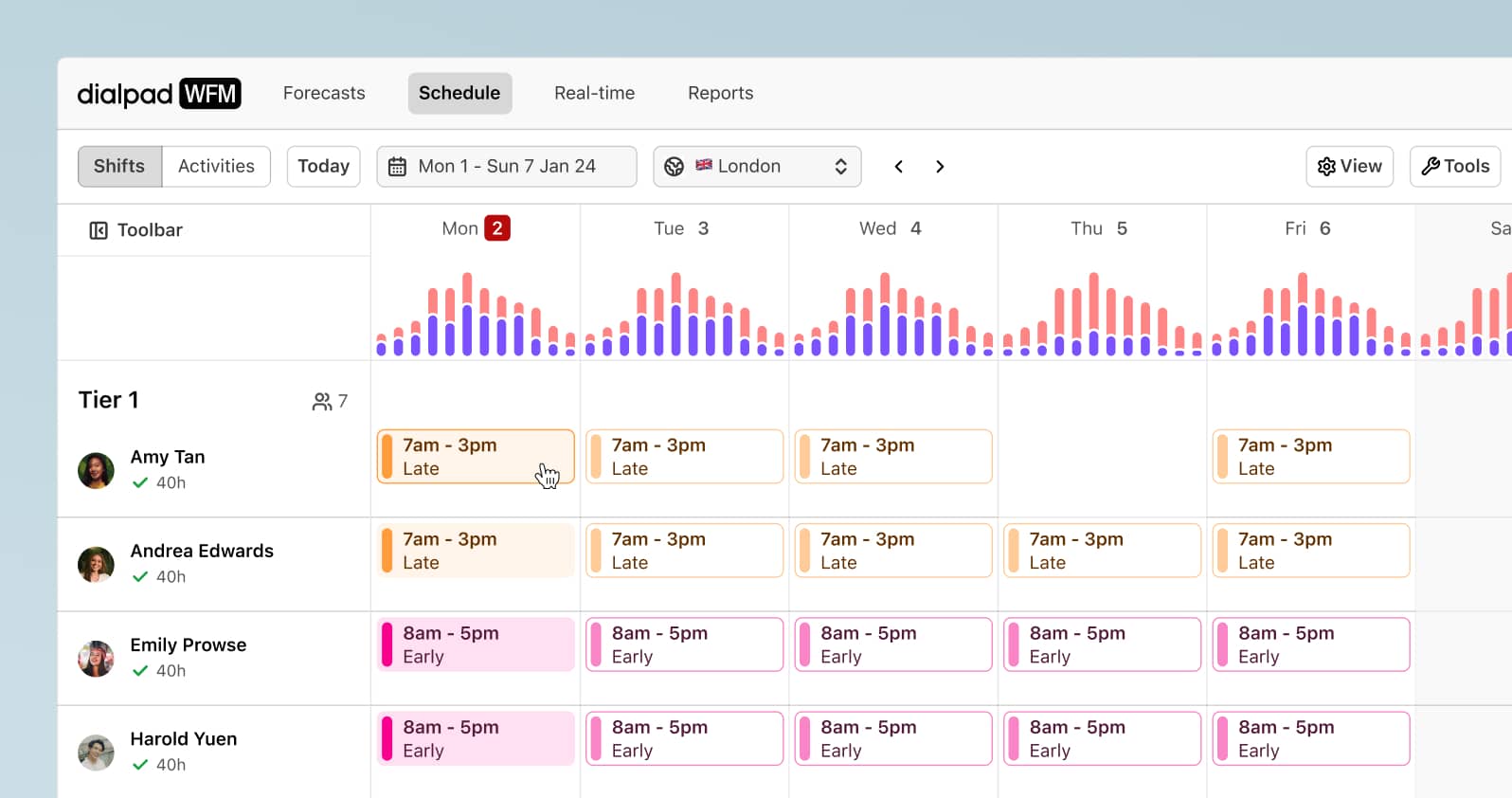Follow-the-sun, lead the market: The 24/7 Support Playbook

Sr Dir. Product Management

Tags
Share
If you’re running a contact centre that operates around the clock, you might be using (or considering) the follow-the-sun model.
It used to be that only the most significant enterprise operations with huge headcounts and extensive resources could afford to offer 24/7 customer support. Still, thanks to this unique model, that’s no longer the case.
Keep reading to learn more about how follow-the-sun works, simple steps to implementing it in your contact centre, and tools to make this process easier.
What is the follow-the-sun support model?
From a contact centre perspective, the follow-the-sun (FTS) model is a customer support approach (SaaS customer support teams in particular like using this) that aims to provide continuous support to customers by seamlessly transitioning work from one geographic location to another as time zones change.
This strategy takes advantage of the time zone differences between various support teams to ensure that customer inquiries are addressed promptly, no matter when they are received.
💡 Dialpad tip:
Notably, FTS did not start out as a customer service strategy! It was actually established in the 1990s by IBM as part of their globally distributed software engineering (GDSE) approach, which had the goal of shortening the time to market for new products.
Principles of follow-the-sun
The original follow-the-sun business model operates based on four key principles, which can be viewed through a contact centre lens, too:
Follow-the-sun model principles: | Follow-the-sun for contact centres: |
|---|---|
1. The main goal is to reduce the time it takes to develop a product and accelerate time to market. | 1. The main goal is to reduce the time it takes to serve a customer and resolve their issue or question. |
2. Teams, or production sites, are scattered across different time zones. | 2. Contact centre teams and agents are scattered across different time zones. |
3. There is always one site that owns and works on the project. | 3. There is always one leader or team that owns overall contact centre performance. |
4. Handoffs are conducted daily at the end of each shift. The next production site is several time zones west. | 4. Handoffs between agents and teams, if needed, happen at the end of each shift. |
Benefits of a follow-the-sun model
Executed well, the follow-the-sun global support model benefits contact centre teams in a few ways:
24/7 customer support
The most obvious benefit is that customers receive support around the clock, leading to higher customer satisfaction and your brand being associated with being accessible at all times.
Faster response times
By strategically placing support teams in various time zones, you can quickly reduce response times and resolve customer inquiries. This also helps avoid building up overnight backlogs on messaging and live chat channels.
Global coverage
The follow-the-sun model is designed to help businesses effectively serve a global customer base, expanding their reach and market presence. This level of coverage is non-negotiable for teams that need to be available at all times. That’s why often you’ll see this model as part of a global company’s HR or IT strategy.)
More flexibility
This model is also very flexible, both in terms of scheduling and resource allocation, allowing you to adapt quickly to changing call volumes and customer demands. If you offer 24/7 customer service, this means you won’t need to spend extra time and effort giving special attention to night shift management.
Improved team collaboration
With the follow-the-sun operating model, support teams across different time zones will learn to collaborate more effectively, sharing best practices and knowledge, which can lead to increased productivity and efficiency overall.
Disadvantages of the follow-the-sun model
There are also some notable disadvantages to follow-the-sun. None of these are critical deal breakers, but it’s best to be at least aware of them in case they do pop up during the implementation process:
Communication silos
One of the natural side effects of having a globally dispersed team is that it’s harder to communicate and keep everyone on the same page. Different team leads might have slightly different ways of doing things, which impacts processes and consistency.
Because of this, it’s helpful to have a unified communications solution that makes it easy for agents and supervisors to message or call each other with questions. Dialpad, for example, has a fully integrated solution with internal communication channels and support features all in one place:
Maintaining consistency across territories
With teams in different regions, it can be harder to maintain the same level of customer service across the board. This is where having good QA scorecards and clear metrics can be useful—this way, every agent is aware of the department-level and individual expectations no matter who the team lead is or how they run their teams.
Cultural integration
As with any global team, there are always cultural differences that may come into play. They don’t always impact the day-to-day work. Still, sometimes, agents may prioritize tasks or communicate with team members differently depending on where they’re from and the working styles typical of those regions.
Is a follow-the-sun model right for you? 3 Factors to consider
Even though follow-the-sun has some unique advantages, it’s important to note that it’s not necessarily a good fit for every business or team.
To determine if this model is right for your agents, customers, and operations, here are a few questions to ask as a jumping-off point.
1. How big is your team?
If you have a small team of fewer than five agents, offering 24/7 support is probably not the best use of your resources. It might be better to offer support during business hours, Monday to Friday instead—even though you’re not quite as available, this won’t overburden your agents and ensures that when customers do call, they can be confident that someone will get to them in a reasonable amount of time.
2. How complex are your customers’ needs?
If most of your customers are reaching out with relatively straightforward questions like “What are your business hours?” or “I need help updating my account details,” you probably don’t need to build a big team and implement a whole new CX strategy.
If you get a lot of complicated questions at all hours of the day that need a live agent—then yes, you should consider the follow-the-sun model. If, on the other hand, it’s just simple questions, a detailed FAQ page or Help Centre should work fine.
3. Are your customers located worldwide and in different time zones?
Are most of your customers in one or two time zones? If so, you probably don’t need to invest in adopting the follow-the-sun model.
On a related note, it would also be helpful to see when your call and messaging volumes are the highest. If your agents are absolutely slammed at a specific time of day, you should account for that in your scheduling. If you’re getting a high volume of inquiries day and night, you may need to follow the sun.
How to implement a follow-the-sun model: Best practices
Although every business will follow a slightly different blueprint when implementing this model, there are a few best practices to keep in mind when establishing the follow-the-sun model in your contact centre.
1. Assess your customer base
To implement the follow-the-sun model, you need first to understand your customer base across several parameters.
This means identifying where your customers are located and the hours they expect to contact you. For example, you might have a customer base only in one region but expect 8am to 8pm service, or you might have customers across five different time zones.
2. Establish support centres in multiple time zones
Select which regions you want to build customer support teams in. You’ll want to look at factors like agents’ ability to service the languages your customers speak, their ability to understand your product and service, costs, and scalability. Don’t forget to make sure you can invest in a management layer to ensure hiring, training, coaching, and quality assurance are always looked after.
3. Define handover protocols
It’s essential to have effective communication and coordination between support teams. Define clear handover protocols to make sure that customer inquiries are seamlessly transferred between teams as time zones shift.
This includes detailing all information that needs to be passed on, which ensures all support teams are on the same page. This is often most critical with pending tickets that don’t get resolved by one team and need to be handed over when shifts change over.
4. Leverage the right technology
There’s a ton of technology out there designed to streamline the handover process and enhance communication between contact centre teams.
Workforce management software helps everyone stay aligned on when they are supposed to be working, what they are working on, and handover tasks between teams or territories. Ideally, your workforce management software can also handle timezones to avoid manual calculations.
For example, you can select a time zone when scheduling in Dialpad WFM, and it auto-adjusts the hours for you. The time zone picker even shows supervisors a birds-eye view of all shifts across every region:

5. Provide consistent and detailed training
To maintain a consistent level of service quality across all support teams, you’ll need to provide comprehensive training for your agents, ensuring they follow the same procedures and standards regardless of their location.
Regular training and updates can help maintain consistency in customer service. The best way to do this is to invest in standardized training materials, FAQ content, and AI tools that can help agents find information more quickly than manually searching your knowledge base.
6. Monitor progress continuously and optimize over time
Implement a system for monitoring and analyzing customer support performance across different time zones. Gather feedback from both customers and your support teams to identify areas for improvement.
For example, you can easily review the performance of multiple teams across different time zones and departments with Dialpad’s time-on-task feature:
Support your follow-the-sun model with round-the-clock communication worldwide from Dialpad
The follow-the-sun model in customer support is a powerful strategy that allows businesses to offer continuous support to a global customer base while optimizing headcount and response times.
To implement a follow-the-sun model effectively, you need to have the right software in place. Workforce management software that schedules different shifts across disparate timezones ensures you can have a follow the sun model that works for your team and works for your customers.
Book a product tour today to learn how to use Dialpad WFM to schedule a follow-the-sun model.
